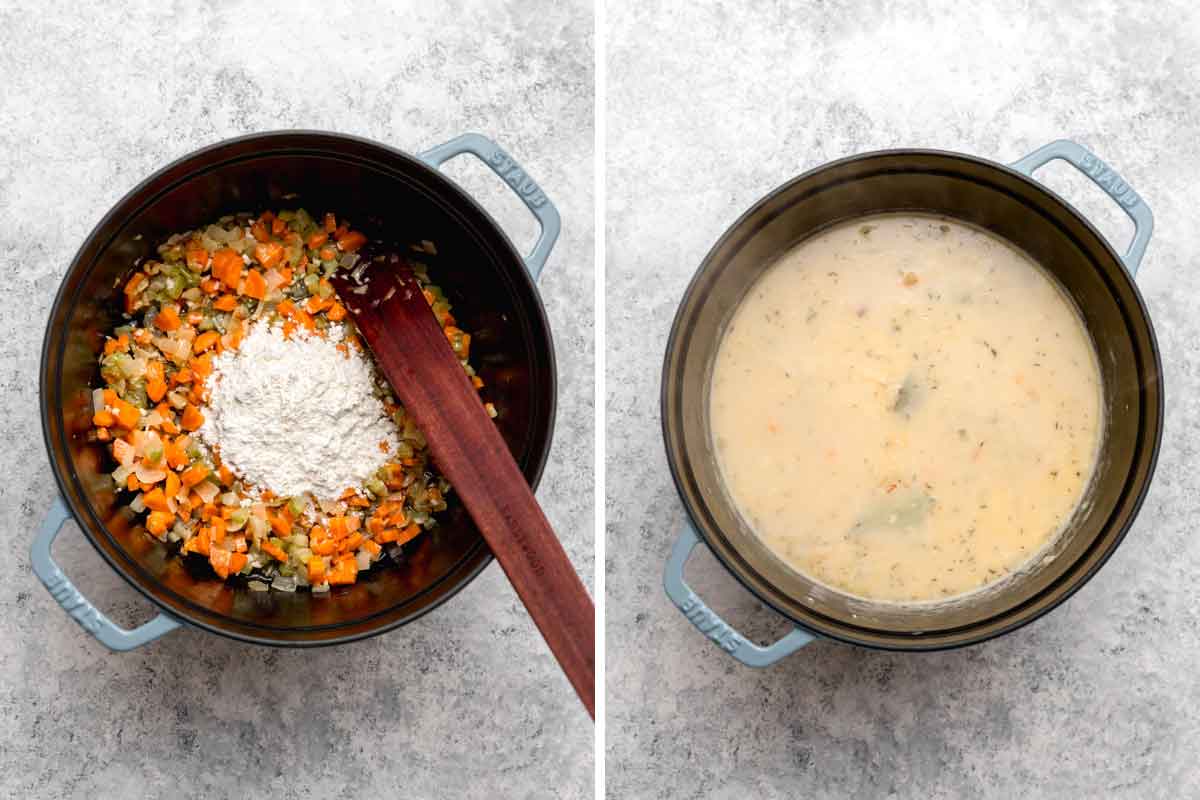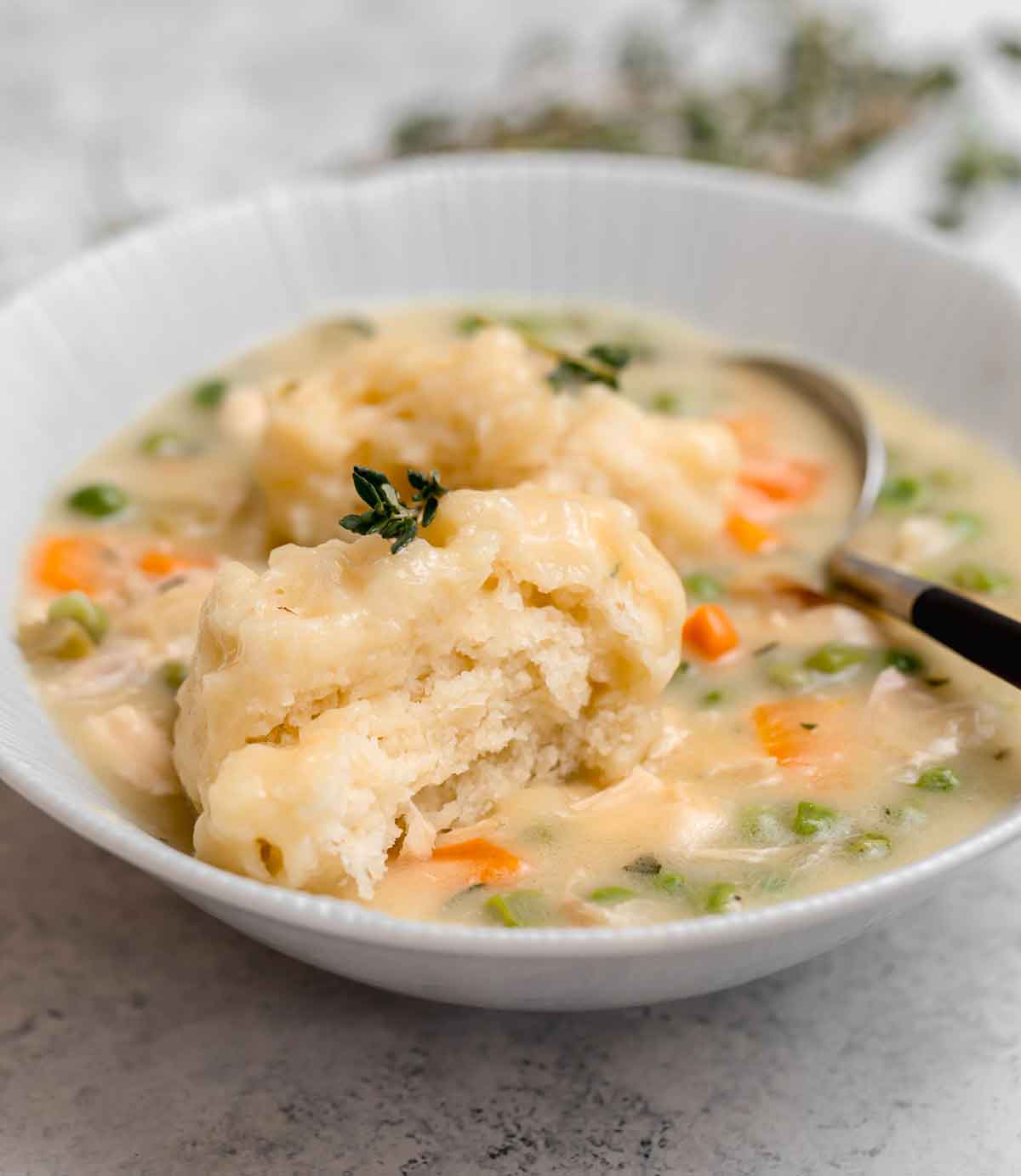Chicken and dumplings is a delicious and comforting meal that many families love. It’s creamy, hearty and perfect for chilly nights. The good news is that you can easily freeze leftover chicken and dumplings so you can enjoy it again later. But how long will it last in the freezer? Here’s what you need to know about freezing chicken and dumplings.
How to Freeze Chicken and Dumplings
To get the best results, it’s important to freeze chicken and dumplings the right way. Here are some tips:
-
Freeze it before cooking. This will help the dumplings maintain their texture better. Place the uncooked chicken and vegetables in one freezer bag, and the dry dumpling mix in another.
-
Cool it completely before freezing. Don’t freeze piping hot chicken and dumplings. Let it cool to room temperature first.
-
Use freezer-safe containers. Opt for bags plastic containers or aluminum pans. Glass could crack.
-
Remove as much air as possible Squeeze out excess air and seal bags tightly
-
Label bags with contents and date. Include heating instructions too.
-
Freeze in smaller portions. Single or double servings thaw faster.
-
Protect quality with freezer paper between layers. Prevent freezer burn.
Following these tips will help homemade chicken and dumplings freeze well so you can enjoy it weeks later!
How Long Does Chicken and Dumplings Last in the Freezer?
Frozen properly, chicken and dumplings can safely last in the freezer for 2-3 months. The shelf life depends somewhat on the ingredients. Here are some general guidelines:
- Chicken – lasts 9 months
- Vegetables – last 8-12 months
- Broth – lasts 2-3 months
- Dumplings – last 1-3 months
The dumplings tend to be the most perishable element. Their texture declines over time. For best quality and taste, enjoy chicken and dumplings within 2-3 months.
If you’ve frozen fully cooked chicken and dumplings, it may not last quite as long. Eat within 1-2 months for optimal freshness.
Tips for Freezing Chicken and Dumplings
Follow these tips to freeze chicken and dumplings like a pro:
-
Use an instant-read thermometer to ensure chicken reaches 165°F internal temperature before cooling.
-
Quickly chill broth to 40°F or below within 2 hours before freezing.
-
Blanch vegetables before freezing to help retain color, texture and nutrients.
-
Use freezer-safe packaging like Ziploc bags, plastic containers or aluminum foil pans.
-
Exclude air and seal tightly. Use a straw to suck out excess air.
-
Portion into single or double servings so it’s easy to thaw just what you need.
-
Place dumplings in a separate bag so they don’t stick together.
-
Wrap frozen bags in freezer paper or foil to prevent freezer burn.
-
Label with contents, quantity and freeze date. Add reheating instructions too.
-
Stack bags flat in freezer to save space and freeze evenly. Don’t overstuff.
-
Once thawed, use chicken and dumplings within 3-4 days. Don’t refreeze.
How to Thaw Frozen Chicken and Dumplings
Chicken and dumplings can be thawed safely using these methods:
-
Refrigerator thawing – For a large batch, thaw in the fridge 1-2 days. Keep at 40°F or below.
-
Cold water method – Seal frozen bag in a bowl of cold tap water. Change water every 30 minutes. Takes 2-3 hours.
-
Microwave – Use the defrost setting to thaw in the microwave, then cook immediately. Don’t partially thaw at room temp.
For food safety, don’t leave chicken and dumplings out at room temperature to thaw. Thaw in the refrigerator for best quality.
How to Reheat Chicken and Dumplings
Once thawed, chicken and dumplings can be reheated in several ways:
-
On the stovetop – Warm over medium-low heat, stirring frequently until heated through.
-
In the oven – Bake at 350°F until hot, 20-25 minutes.
-
In the slow cooker – Add to a slow cooker with 1/2 cup broth. Cook on Low 2-3 hours.
-
In the microwave – Microwave individual portions on Medium, stirring every minute.
-
On the grill – Pour into an aluminum pan. Grill over indirect heat with lid closed 15-20 minutes.
Bring the broth to a low simmer or 165°F. Cook dumplings just until warmed through. Avoid boiling or they may fall apart.
With the right freezing and thawing methods, leftover chicken and dumplings can taste just as delicious reheated later!
Signs Your Frozen Chicken and Dumplings Has Gone Bad
How can you tell if frozen chicken and dumplings has spoiled? Here are some signs to watch for:
- Unpleasant odors, sour smell
- Change in color, graying of chicken
- Dry, shriveled dumplings
- Unusual sliminess or texture
- Presence of ice crystals or freezer burn
- Mold growth anywhere
- Past recommended freezer time of 2-3 months
If your frozen chicken and dumplings shows any of these signs, it’s best to discard it. Don’t taste or eat spoiled frozen foods. When in doubt, throw it out.
FAQs About Freezing Chicken and Dumplings
Can you freeze cooked chicken and dumplings?
Yes, it’s safe to freeze fully cooked chicken and dumplings. However, the dumplings will absorb more liquid, fall apart and turn mushy more easily. For best results, freeze uncooked.
Do chicken and dumplings freeze well?
Chicken and dumplings can freeze well up to 2-3 months with proper packaging. The dumplings may get mushy over time. Portion into single servings to limit freezer time.
Can chicken and dumplings be refrozen after thawing?
It’s not recommended to refreeze chicken and dumplings after thawing. Refreezing can allow bacteria to grow. For safety and quality, thaw only what you plan to eat within 3-4 days.
What container is best for freezing chicken and dumplings?
Freezer bags, rigid plastic containers or aluminum foil pans all work well. Glass could crack. Make sure containers seal tightly. Remove air pockets.
Should you thicken broth before freezing chicken and dumplings?
For easier reheating, you can thicken broth slightly with a roux or cornstarch before freezing. But it’s not required if you’ll simmer until hot when reheating.
Enjoy Delicious Chicken and Dumplings Any Time
With proper freezing techniques, you can enjoy comforting chicken and dumplings for up to 3 months after cooking. Portion into single servings for quick thawing. Label bags clearly and avoid freezer burn. Thaw in the fridge or microwave, then reheat gently until hot. Follow these tips and your homemade chicken and dumplings will taste freshly made whenever you need a hearty, homestyle meal.

How To Make The Soup Base
First, we need to make the soup. Begin with a common soup starter trio — onion, carrots, and celery — aka a mirepoix. They are sautéed in butter, and then we add garlic to cook for a minute or so, just until it’s aromatic and not letting it burn.
Then we need to make a roux to thicken the chicken stew base. Stir in the flour until it is thoroughly cooked through, the vegetables are coated, and the roux starts to brown. Then, add the chicken stock and stir to incorporate before adding the heavy cream, salt, pepper, thyme, and bay leaves. Let all of that simmer while you prepare the dumplings.

Instant Pot Chicken and Dumplings
To make this recipe in a pressure cooker, follow these instructions:
- Prepare the dumpling dough first and place in the refrigerator.
- Use the saute function of the pressure cooker to complete steps #2 and #3 below.
- Stir the chicken, peas, and parsley into the pot. Drop the dumpling mixture by large spoonfuls of dough over the surface of the chicken stew.
- Close the pressure cooker lid and set it to pressure cook high for 7 minutes. When complete, do a natural release, then remove the lid per the manufacturer’s directions.

- To make this a quick dinner, use a cooked rotisserie chicken from the grocery store.
- If cooking the chicken from scratch, I like to use chicken thighs because they are more flavorful, but you can use skinless chicken breasts as well. Prepare any way you’d like – saute in a pan, poach, or roast in the oven, then chop. I typically use about 2 pounds of boneless, skinless chicken thighs for this recipe.
- For uniform dumplings, I like to use a medium cookie scoop, which holds about 1½ tablespoons, for dropping the dough into the pot.
- A medium (5.5-quart) or large (7.25-quart) Dutch oven are both perfect for making this recipe.
